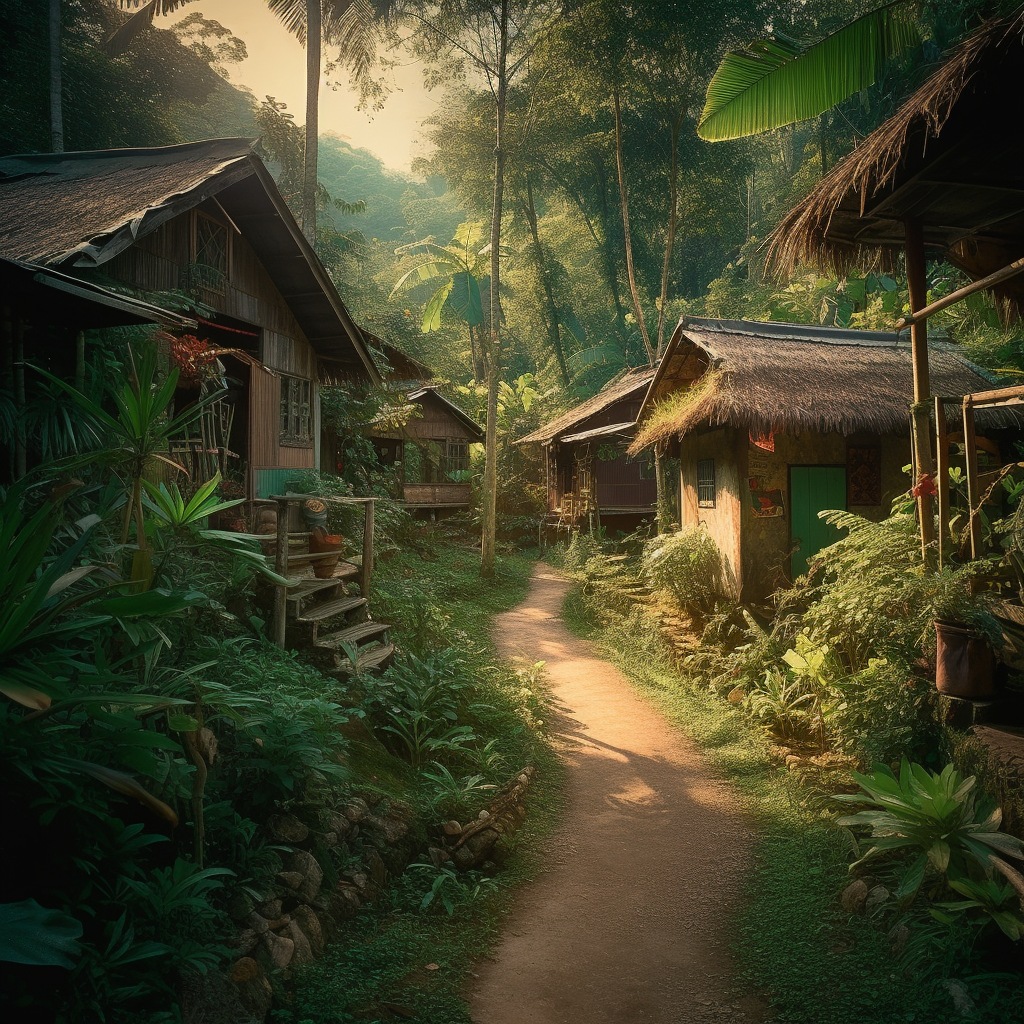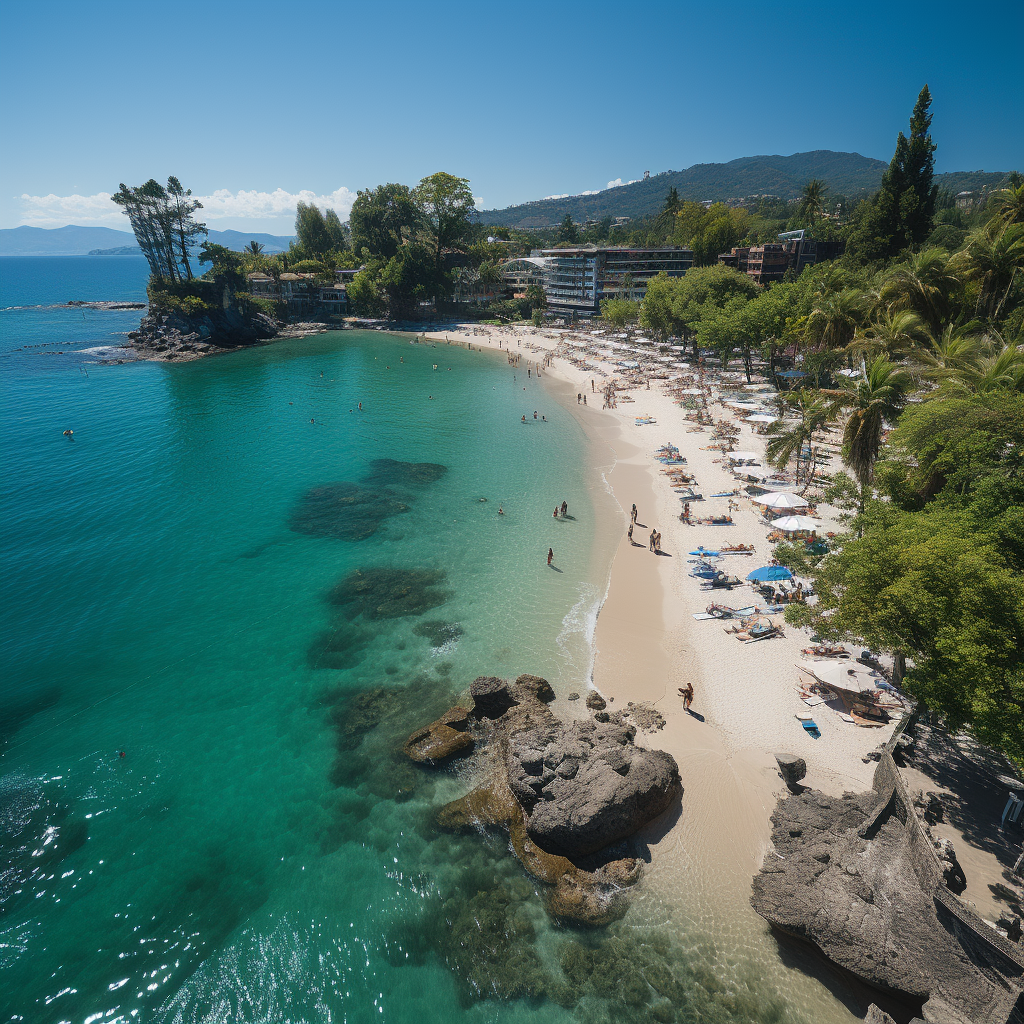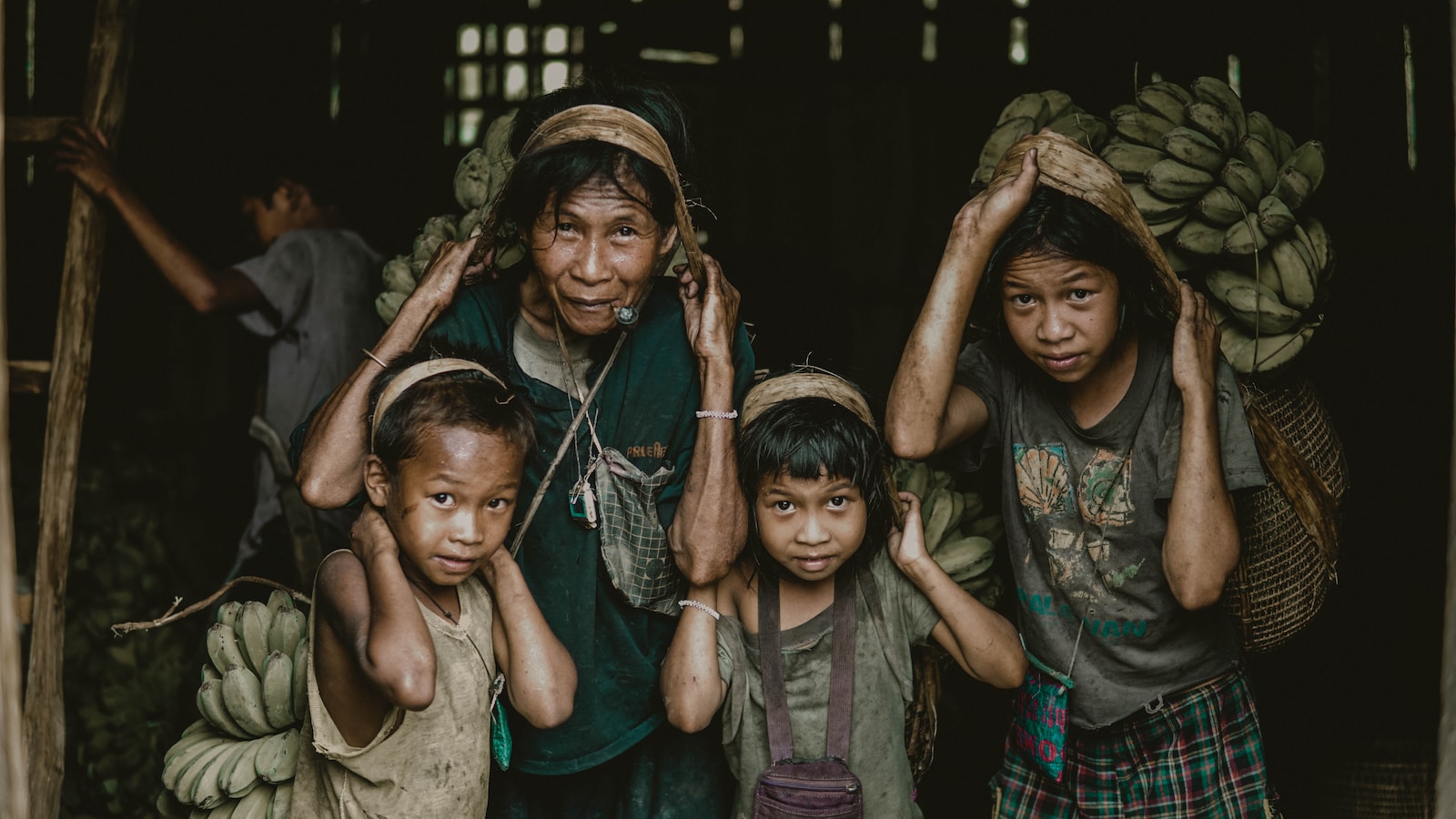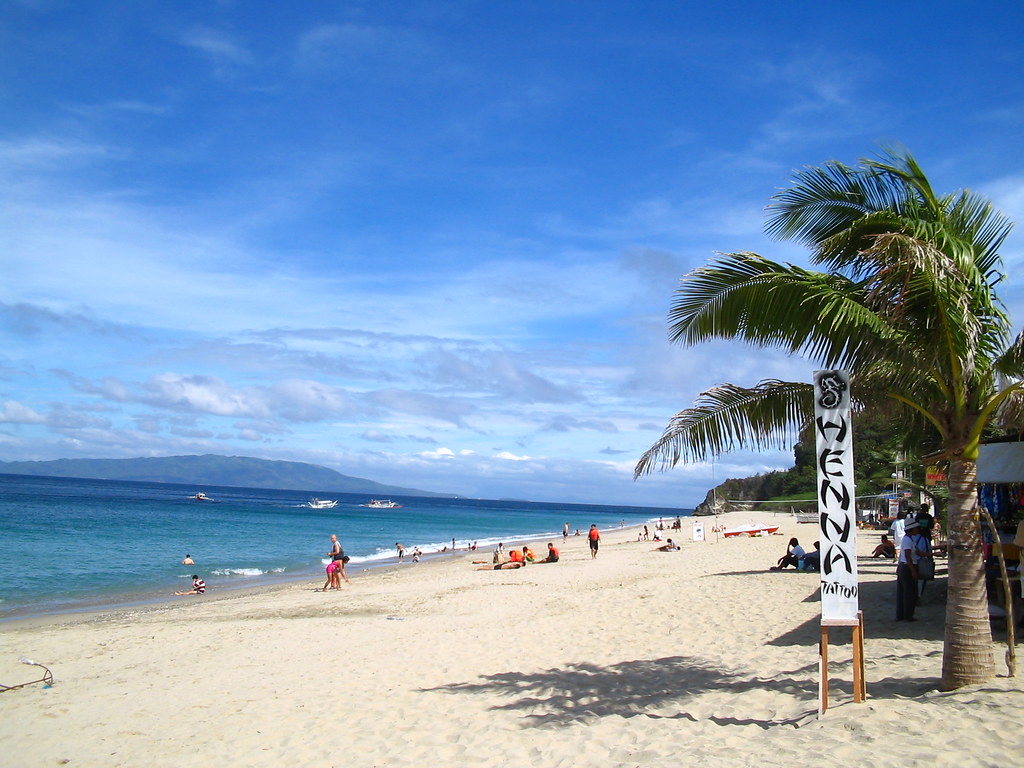Mangyan Village is a small community located in Puerto Galera, Philippines. The village is home to the Mangyan people, one of the indigenous groups in the country. The Mangyan people are known for their unique culture and way of life, which have been preserved for centuries despite the influence of modernization.
The village is situated in a scenic location, surrounded by lush forests and hills. It is a popular destination for tourists who want to experience the beauty of rural life and learn about the Mangyan culture. Visitors can take part in various activities such as trekking, cultural tours, and handicraft-making workshops. The community also has a market where they sell their traditional products such as woven baskets, mats, and clothing.
Despite the village’s picturesque surroundings, the Mangyan people face various challenges such as poverty, lack of access to education and healthcare, and discrimination. However, efforts are being made to address these issues through community-based initiatives and government programs. Overall, Mangyan Village provides a glimpse into the unique and fascinating culture of the Mangyan people and their way of life in the Philippines.
History and Background
Mangyan Village is a community located in Oriental Mindoro, Philippines. The Mangyans are one of the indigenous groups in the country, and they have a rich cultural heritage that has been preserved for centuries. The village is situated near the river and covers a vast area of land.
The history of the Mangyans dates back to pre-colonial times, and they have managed to maintain their unique way of life despite the changes brought by modernization. The Mangyans have their language, customs, and traditions that have been passed down from generation to generation.
Jaime Zobel de Ayala, through the Ayala Foundation, has been instrumental in helping the Mangyan community. The foundation has implemented various programs to improve the lives of the Mangyans, including education and healthcare initiatives. These programs have helped the Mangyans to become more self-sufficient and to preserve their cultural heritage.
The Mangyans have faced many challenges over the years, including discrimination and marginalization. However, with the help of organizations like the Ayala Foundation, the Mangyans have been able to overcome these challenges and continue to thrive.
In conclusion, the Mangyan Village is a unique community that has managed to preserve its culture and heritage despite the changes brought by modernization. With the help of organizations like the Ayala Foundation, the Mangyans have been able to improve their lives and continue to thrive.
Geography and Location
Mangyan Village is located in the northern part of the island of Mindoro in the Philippines. The village is situated in the Alangan-Mangyan region, which is known for its mountainous terrain and lush forests. The village is surrounded by several mountains, including Mt. Malasimbo, which is a popular destination for hikers and nature enthusiasts.
The land in the Alangan-Mangyan region is predominantly forested, with a mix of lowland and upland forests. The region is also home to several rivers and streams, which provide water for the community and support a diverse range of flora and fauna.
Mangyan Village is part of the municipality of Mansalay, which is located on the eastern coast of Mindoro. Mansalay is known for its beautiful beaches and is a popular tourist destination. The town is also home to several cultural and historical landmarks, including the Mansalay Church and the Mansalay Museum.
Overall, Mangyan Village’s location in the Alangan-Mangyan region and its proximity to Mt. Malasimbo and the town of Mansalay make it an ideal destination for those interested in nature, culture, and history.
Community and Lifestyle
The Mangyan Village is a community of indigenous people located in the Occidental Mindoro province of the Philippines. The community is made up of families who have lived in the area for generations. The Mangyan people are known for their unique culture and lifestyle, which is deeply rooted in their connection to the land and nature.
The Mangyan Village is a close-knit community where everyone knows each other. The population of the village is relatively small, and everyone works together to ensure that the community thrives. Children play an essential role in the community, and they are taught from a young age to respect their elders and to take care of the land.
The lifestyle of the Mangyan people is based on a deep connection to nature. They rely on the land for their food and livelihoods, and they have a deep respect for the environment. The community practices sustainable agriculture and fishing methods, which ensure that the land and sea remain healthy and productive for future generations.
The Mangyan people have a rich cultural heritage, which is reflected in their daily life. They have their language, music, dance, and traditional clothing, which they proudly showcase during festivals and celebrations. The community also has a strong spiritual connection to nature, and they believe in the importance of maintaining a balance between humans and the environment.
In summary, the Mangyan Village is a unique community of indigenous people who have a deep connection to the land and nature. The community is made up of families who work together to ensure that their way of life thrives. Children play an essential role in the community, and they are taught from a young age to respect their elders and take care of the land. The lifestyle of the Mangyan people is based on sustainable agriculture and fishing methods, and they have a rich cultural heritage that is deeply rooted in their connection to nature.
Cultural Heritage
The Mangyan Village is rich in cultural heritage, with traditions and customs that have been passed down through generations. The Mangyan people take great pride in their heritage and are working to preserve and promote it for future generations.
Language and Literature
The Mangyan people have their own unique language, which is distinct from Tagalog and other Philippine languages. They have two syllabic scripts, the Hanunoo and Buhid Mangyan scripts, which are used to write their literary works, including the ambahan, a form of poetry that expresses their thoughts and feelings. Today, efforts are being made to revive and preserve these scripts and literature, as they are an important part of Mangyan cultural heritage.
Traditions and Customs
Mangyan traditions and customs are deeply rooted in their way of life, which is closely tied to the natural environment. They have a strong sense of community and place great importance on family, respect, and hospitality. Their traditional practices include farming, hunting, and fishing, which are done in a sustainable and respectful manner. They also have unique practices related to marriage, childbirth, and death, which are steeped in tradition and symbolism.
Music and Dance
Music and dance are an integral part of Mangyan culture and are used to express their emotions and celebrate important events. They have a rich tradition of music, which includes the use of traditional instruments such as the kudyapi, a type of guitar, and the tungtung, a bamboo percussion instrument. Their dances are often performed during festivals and other celebrations and are characterized by their graceful movements and colorful costumes.
Overall, the Mangyan Village’s cultural heritage is a source of pride and inspiration for its people. Efforts to preserve and promote their traditions and customs are ongoing, and the community is working to ensure that future generations can continue to appreciate and learn from their rich cultural legacy.
Indigenous Groups
The Mangyan Village is home to several indigenous groups, each with their unique language and culture. These groups have been living in the area for centuries, preserving their traditions and way of life.
Iraya
The Iraya are one of the six indigenous groups found in the Mangyan Village. They are known for their intricate basket weaving and traditional farming practices. The Iraya language is also one of the few Mangyan languages that have a written form.
Hanunuo
The Hanunuo Mangyans are another indigenous group found in the Mangyan Village. They are known for their syllabic script, which is used to write their language. The Hanunuo Mangyans have a strong connection to nature and practice animism, which is the belief that everything has a spirit.
Buhid
The Buhid are another indigenous group found in the Mangyan Village. They have a rich oral tradition, which includes epic poems and songs. The Buhid language is also written in a syllabic script, similar to the Hanunuo Mangyans.
Alangan
The Alangan are an indigenous group found in the mountainous areas of the Mangyan Village. They are known for their intricate beadwork and traditional clothing. The Alangan language is also one of the few Mangyan languages that have a written form.
Tadyawan
The Tadyawan are another indigenous group found in the Mangyan Village. They are known for their traditional music and dance, which is often performed during special occasions. The Tadyawan language is also written in a syllabic script, similar to the Hanunuo Mangyans and Buhid.
Bangon
The Bangon are an indigenous group found in the coastal areas of the Mangyan Village. They have a strong connection to the sea and practice traditional fishing methods. The Bangon language is also one of the few Mangyan languages that have a written form.
Ratagnon
The Ratagnon are another indigenous group found in the Mangyan Village. They are known for their traditional weaving and pottery. The Ratagnon language is also written in a syllabic script, similar to the Hanunuo Mangyans, Buhid, and Tadyawan.
Overall, the indigenous groups in the Mangyan Village have a deep respect for their traditions and culture. They have managed to preserve their way of life despite the challenges they face from modernization and development.
Education and Learning
The Mangyan people recognize the importance of education and are open to formal education. However, their elders still prefer that they stay within the village and learn traditional skills.
Formal education has been slowly introduced to Mangyan villages in the mountains, with schools being built to provide education to children. However, there are still challenges in terms of access to education, as some villages are located in remote areas that are difficult to reach.
Despite these challenges, the Mangyan children are eager to learn and are receptive to new knowledge. They see the value of education and how it can benefit not just themselves but also their community.
In addition to formal education, the Mangyan people also have their own traditional ways of learning. They have their own stories, songs, and dances that are passed down from generation to generation. These traditional practices help preserve their culture and identity.
Overall, the Mangyan people have a strong desire to learn and are open to both formal and traditional ways of learning. With continued support and access to education, the Mangyan children can have a brighter future and contribute to the development of their community.
| Pros | Cons |
|---|---|
| Mangyan children are receptive to new knowledge | Some villages are located in remote areas that are difficult to reach |
| The Mangyan people have their own traditional ways of learning | Access to education can be a challenge |
| Formal education has been slowly introduced to Mangyan villages | Some elders still prefer that children stay within the village and learn traditional skills |
In conclusion, education and learning are highly valued by the Mangyan people. While there are still challenges in terms of access to education, the Mangyan children are eager to learn and are open to both formal and traditional ways of learning.
Local Economy
The Mangyan Village has a local economy that is primarily based on agriculture, handicrafts, and weaving.
Agriculture
Agriculture is the main source of income for the villagers. The Mangyans practice traditional farming methods, which involve the use of simple tools and manual labor. They grow crops such as rice, corn, and root crops. They also raise livestock such as pigs, chickens, and goats.
Handicrafts and Weaving
Handicrafts and weaving are also important sources of income for the villagers. The Mangyans are known for their skill in making handicrafts such as nito, bamboo, and rattan baskets. They also make traditional handicrafts such as mats, bags, and hats.
Weaving is another important skill that is passed down from generation to generation. The Mangyans weave using traditional methods and materials such as nito and reed. They use the woven products for various purposes such as baskets, mats, and hats.
In recent years, the Mangyan Village has started to explore the production of nito products such as bags, hats, and baskets. These products are sold in the local market and are gaining popularity among tourists.
Overall, the local economy of the Mangyan Village is centered around agriculture and traditional handicrafts. The villagers have managed to sustain their livelihoods through their skills and knowledge of traditional methods.
Architecture and Housing
Mangyan Village is known for its unique and traditional architecture. The houses in the village are made of bamboo and wood, which are locally sourced materials. The Mangyan people have been building houses using these materials for generations, and their expertise in using them is evident in the quality of their houses.
The traditional houses in Mangyan Village are built on stilts, which help protect them from flooding during the rainy season. The roofs are made of thatch, which is a type of grass that is commonly used in the Philippines for roofing. The walls of the houses are made of bamboo, which is a strong and durable material that can withstand strong winds and rain.
The Mangyan people have a deep respect for nature, and this is reflected in their architecture. They use sustainable materials that are readily available in their environment, and they build their houses in a way that is harmonious with nature. The houses are designed to allow for natural ventilation, which helps keep them cool during the hot summer months.
The houses in Mangyan Village are not just functional structures, but they are also works of art. The Mangyan people have a rich tradition of art and craftsmanship, and this is evident in the intricate designs that adorn their houses. The houses are decorated with carvings and paintings that depict scenes from nature, such as animals and plants.
In conclusion, the architecture and housing in Mangyan Village is a testament to the ingenuity and creativity of the Mangyan people. Their use of sustainable materials and their respect for nature is something that we can all learn from.
Tourism and Travel
Attractions
Mangyan Village is a hidden gem in the Philippines that offers unique cultural experiences and breathtaking natural scenery. Tourists can explore the village’s rich history and traditions by visiting the Iraya Mangyan Village, where they can learn about the Mangyan people’s way of life and even participate in traditional activities such as weaving and farming.
For those seeking adventure, the village offers a bamboo bridge that spans across a river and provides stunning views of the surrounding forest. Nearby, travelers can also visit the Sitio Talipanan, a picturesque beach with crystal-clear waters and white sand.
Accommodations
While the village itself does not offer many lodging options, there are several resorts and hotels in the nearby area that provide comfortable and convenient accommodations for tourists. One such option is the White Beach Resort, which offers beachfront rooms and a variety of amenities such as a swimming pool and restaurant.
For those interested in learning more about the region’s history and culture, the Mangyan Museum is a must-visit destination. The museum features exhibits on the Mangyan people’s art, language, and customs, providing visitors with a deeper understanding of the village’s rich heritage.
Overall, Mangyan Village is a destination that offers something for everyone, from adventure seekers to cultural enthusiasts. With its stunning natural scenery, unique cultural experiences, and comfortable accommodations, it is a must-visit destination for anyone traveling to the Philippines.
Preservation Efforts
Preserving the culture and traditions of the Mangyan Village has been a continuous effort by various organizations, philanthropists, and the indigenous group themselves. The Mangyan Mission has been instrumental in documenting, preserving, and propagating the Hanunoo and Buhid Mangyan syllabic scripts of the Philippines. Their efforts have been continuous and dedicated.
Several organizations have also been supporting the Mangyan Village in their preservation efforts. First Peoples Worldwide, for example, has been working with the Maasai villagers to familiarize them with the new constitution and preserve and study traditional languages. The Mangyan Village has also received support from the government and other non-government organizations.
The indigenous group themselves have been making every effort to preserve their culture and way of life. In Barangay Baras, another Iraya Mangyan Village, the community encourages their young to continue practicing their culture and traditions. They recognize the importance of collective will and individual efforts to preserve their rich culture and traditions.
Preservation and identity construction are also highlighted in the literature on Mangyan music. While the preservation effort is compatible with the environment, it is important to ensure that it is sustainable and does not cause any harm to the environment.
In conclusion, the preservation efforts for the Mangyan Village have been continuous and dedicated. The support from various organizations, philanthropists, and the indigenous group themselves has been instrumental in preserving their culture and traditions.




![Isora Resort [Review]](https://www.puertogalera.ph/wp-content/uploads/2023/07/d7m5xramf8g.jpg)



